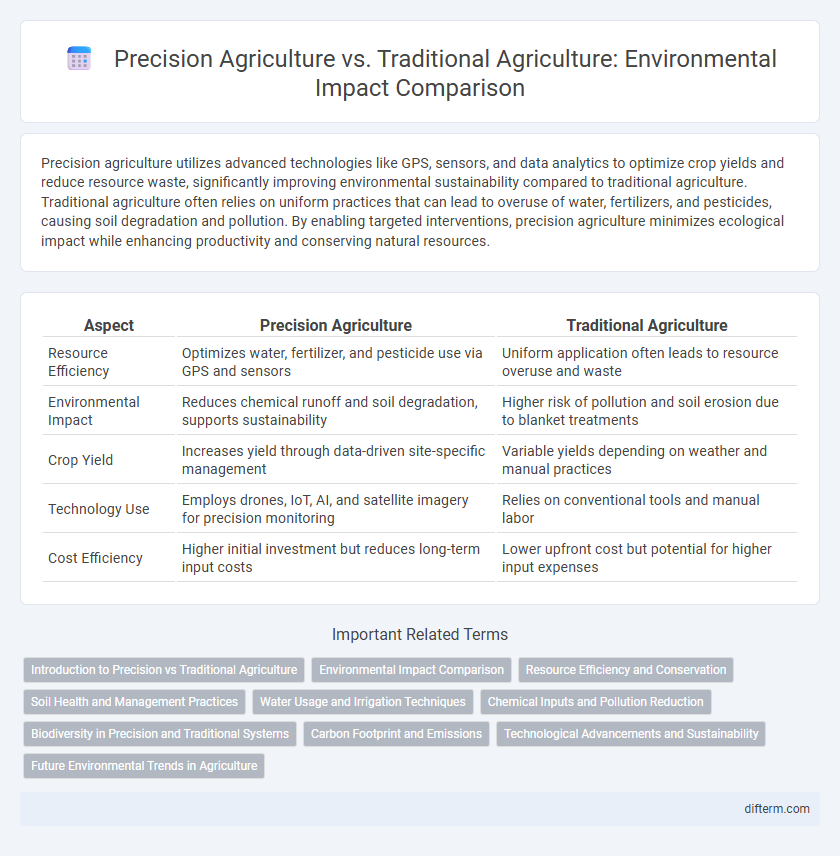Precision agriculture utilizes advanced technologies like GPS, sensors, and data analytics to optimize crop yields and reduce resource waste, significantly improving environmental sustainability compared to traditional agriculture. Traditional agriculture often relies on uniform practices that can lead to overuse of water, fertilizers, and pesticides, causing soil degradation and pollution. By enabling targeted interventions, precision agriculture minimizes ecological impact while enhancing productivity and conserving natural resources.
Table of Comparison
| Aspect | Precision Agriculture | Traditional Agriculture |
|---|---|---|
| Resource Efficiency | Optimizes water, fertilizer, and pesticide use via GPS and sensors | Uniform application often leads to resource overuse and waste |
| Environmental Impact | Reduces chemical runoff and soil degradation, supports sustainability | Higher risk of pollution and soil erosion due to blanket treatments |
| Crop Yield | Increases yield through data-driven site-specific management | Variable yields depending on weather and manual practices |
| Technology Use | Employs drones, IoT, AI, and satellite imagery for precision monitoring | Relies on conventional tools and manual labor |
| Cost Efficiency | Higher initial investment but reduces long-term input costs | Lower upfront cost but potential for higher input expenses |
Introduction to Precision vs Traditional Agriculture
Precision agriculture leverages advanced technologies such as GPS, IoT sensors, and data analytics to optimize crop yields, reduce resource use, and minimize environmental impact. Traditional agriculture relies on uniform practices and manual observation, often resulting in inefficiencies and higher input waste. The integration of site-specific data in precision farming enables targeted interventions that enhance sustainability and productivity compared to conventional methods.
Environmental Impact Comparison
Precision agriculture significantly reduces environmental impact by optimizing resource use such as water, fertilizers, and pesticides, leading to decreased soil degradation and lower greenhouse gas emissions. Traditional agriculture often involves over-application of chemicals and inefficient water use, contributing to soil erosion, nutrient runoff, and increased carbon footprint. Advanced technologies like GPS-guided equipment and remote sensing enable precision farming to enhance crop yields while minimizing damage to surrounding ecosystems.
Resource Efficiency and Conservation
Precision agriculture utilizes advanced technologies such as GPS, sensors, and data analytics to optimize water, fertilizer, and pesticide usage, significantly reducing waste and environmental impact compared to traditional agriculture. This method enhances resource efficiency by targeting inputs precisely where needed, conserving soil health and promoting sustainable crop production. Traditional agriculture often relies on uniform application of resources, leading to overuse, runoff, and degradation of natural resources.
Soil Health and Management Practices
Precision agriculture utilizes advanced technologies like GPS mapping and soil sensors to monitor soil health in real-time, enabling targeted interventions that reduce soil degradation and nutrient runoff compared to traditional agriculture. Traditional practices often rely on uniform application of water, fertilizers, and pesticides, which can lead to soil compaction, erosion, and depletion of essential nutrients. By optimizing resource use and promoting sustainable soil management, precision agriculture enhances soil structure, moisture retention, and microbial activity, contributing to long-term soil fertility and environmental resilience.
Water Usage and Irrigation Techniques
Precision agriculture significantly reduces water usage by utilizing advanced sensors and satellite data to deliver precise irrigation based on soil moisture levels, unlike traditional agriculture which often relies on uniform watering schedules that result in water wastage. Technologies such as drip irrigation and variable rate irrigation in precision farming optimize water distribution, enhancing crop yield while conserving resources. These targeted methods minimize runoff and evaporation, making precision agriculture a sustainable alternative for managing freshwater resources efficiently.
Chemical Inputs and Pollution Reduction
Precision agriculture uses advanced technologies like GPS and soil sensors to apply chemical inputs precisely where needed, significantly reducing excess fertilizer and pesticide use compared to traditional agriculture. This targeted approach minimizes chemical runoff into water sources, lowering pollution levels and environmental impact. Studies indicate that precision farming can reduce nitrogen fertilizer usage by up to 30%, leading to healthier ecosystems and improved soil quality.
Biodiversity in Precision and Traditional Systems
Precision agriculture enhances biodiversity by minimizing chemical inputs and optimizing resource use, which reduces habitat disruption and promotes soil health compared to traditional agriculture. Traditional farming often relies on monoculture and intensive pesticide use, leading to habitat loss and a decline in species diversity. Integrated sensor technologies and site-specific management in precision agriculture support diverse ecosystems by maintaining natural habitats within farmland.
Carbon Footprint and Emissions
Precision agriculture significantly reduces the carbon footprint by optimizing resource use and minimizing waste, leading to lower greenhouse gas emissions compared to traditional farming methods. By employing technologies such as GPS-guided equipment and variable rate application of fertilizers and pesticides, precision agriculture enhances efficiency and reduces fuel consumption. Consequently, this approach supports sustainable farming practices that contribute to mitigating climate change impacts.
Technological Advancements and Sustainability
Precision agriculture leverages advanced technologies such as GPS-guided equipment, IoT sensors, and data analytics to optimize resource use, reduce waste, and increase crop yields. Traditional agriculture often relies on uniform application of inputs, leading to higher inefficiencies and greater environmental impact. Technological advancements in precision farming enhance sustainability by minimizing chemical runoff, conserving water, and promoting soil health through targeted interventions.
Future Environmental Trends in Agriculture
Precision agriculture leverages advanced technologies such as GPS, IoT sensors, and data analytics to optimize resource use, significantly reducing water consumption and chemical runoff compared to traditional agriculture. Future environmental trends highlight a shift towards sustainable farming practices that emphasize soil health, biodiversity preservation, and carbon footprint reduction through precision techniques. Increased adoption of AI-driven crop monitoring and automated systems is expected to enhance efficiency, minimize environmental impact, and support climate-resilient agricultural production.
precision agriculture vs traditional agriculture Infographic

 difterm.com
difterm.com